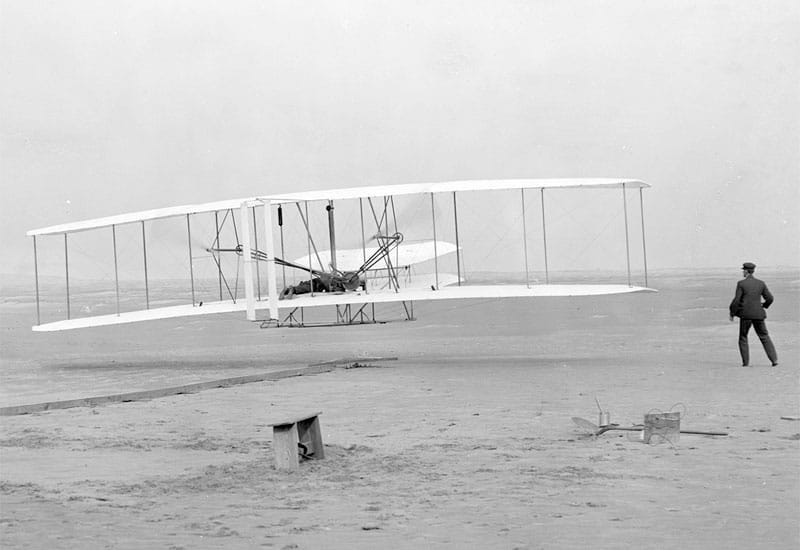by Rod D. Martin
December 17, 2003
When Orville and Wilbur Wright launched their Flyer into the history books, one hundred years ago this day, they could not possibly have imagined the consequences of their act.
And neither could anyone else.
Man had dreamed of flight probably since the Garden; but as late as 1895 Lord Kelvin, President of the Royal Society, joined in the opinion of the greatest inventor of the age, Thomas Edison, that heavier-than-air flight was impossible. Indeed, Samuel P. Langley, Director of the Smithsonian Institution and head of an expensively-funded government project to invent the airplane, proclaimed the goal years if not decades off just days before Kitty Hawk, after crashing his own experimental craft into the Potomac.
But it did not stop there. Even as other men -- notably Count Ferdinand von Zeppelin -- raced ahead with lighter-than-air craft, even establishing regular passenger service in Germany before The Great War and across the Atlantic thereafter, there remained a certain schizophrenia, and a distinct lack of vision, concerning what the Wrights had wrought. The public was transfixed: barnstormers swept not only America but Europe as well, and contests were endlessly held as pilots sought to push the envelope: higher, farther, faster.
But others were not so sure. Even as the Daily Mail proclaimed in 1906 that the day would come when London’s skies were darkened by the sheer number of airplanes, and air power would eclipse sea power as the dominant force on Earth, the same year The Times pronounced that all attempts at “artificial aviation” were “foredoomed to failure”; and a year later, the British Admiralty opined that areoplanes could be of “no practical use” to the Navy.
It cost Billy Mitchell his career -- sixteen years and a whole World War later -- to dispel that fallacy; but it took a Second World War to really prove the point. And meantime, many other “can’t-be-dones” arose, from Orville Wright’s own prediction that “no flying machine will ever fly from New York to Paris” to the near-axiom that man could never fly as fast as the speed of sound.
And yet jet airliners, nuclear-armed intercontinental bombers and supersonic interceptors were all part of the daily life of the world just a half-century from Kitty Hawk. And the wonders were just beginning; for, however less “sex-appeal” there might be to FedEx than to the Bell X-1, can anyone honestly argue that the former has had less impact on our lives? Surely the near-complete replacement of intercity trains with regular airline service in the generation following World War II -- not to mention the complete replacement of ocean liners by their flying kin -- is as marvelous as any achievement of man. And as to the military application, one need only imagine the late wars in Iraq and Afghanistan in a world without air power to grasp at least a glint of the difference a century has made.
It is this backdrop which informs our future; and also the skepticism that claimed all those things impossible. They will claim the future impossible as well; yet it will come.
And what is that future?
It has already flown, over the desert of Australia, just a year shy of this anniversary. It was named one of Time Magazine’s “Best Inventions of 2002”, it took forty years of research to produce, and it is every bit as revolutionary as the Wright Flyer itself.
It is called the Scramjet.
An acronym for “supersonic combustion ramjet”, scramjets solve a key problem which has plagued aviation and astronautics for a half-century: that ramjets cannot much exceed Mach 3 in stable flight. Our fastest deployed craft, the SR-71, pushes this to the limit, but physics is physics: a ramjet must slow its intake to subsonic speeds to combust its fuel. Failing to do so blows out the fire; attempting to do so beyond a certain speed can literally melt the engine. And so, but for test vehicles like the X-15 rocket plane, Mach 3 has been an impenetrable barrier, a “demon in the air”.
But as the name implies, supersonic combustion ramjets -- employing designs so complex they could not be created until the very latest generation of computers -- are unencumbered by this flaw. Though experimental now, they will ultimately be able to take off and land at an airport like any other plane, accelerating in the meantime to near escape velocity (the speed required to enter orbit) under their own power. In so doing, they will fulfill Ronald Reagan’s dream of an “Orient Express” which can reach any point on Earth from any other in at most two hours. They will also, with a tiny reusable booster attached, be able to take passengers and cargo to space as easily as they might go today to San Jose.
Routine hypersonic flight will change our world in ways which will make the 20th Century look like the 19th. Particularly when combined with NASA’s newly-developed technology to eliminate sonic booms, people will travel the world like they today fly home to see grandma; and unimaginable cultural and business opportunities will blossom as the world becomes as small as a single country is today.
But access to space will overshadow all of that: not merely the tourism and research contemplated today, but access to vast mineral deposits cheaply mined without environmental consequence, limitless solar power beamed cleanly back to Earth, advanced manufacturing without atmospheric pollution or the limits of gravity, and, surely by the end of the new century, vast settlements for an ever-increasing number of our planet’s ever-multiplying throng.
Perhaps you laugh. Perhaps you say it will never be. But you are not the first in your skepticism; and the future continues marching right along.




